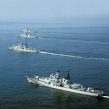
PLAN East Sea Fleet Moves Beyond First Island Chain
Publication: China Brief Volume: 10 Issue: 9
By:

The People’s Liberation Army Navy (PLAN) recently carried out its annual exercises far from China’s coastal waters. The flotillas of naval warships were reportedly deployed on an unprecedented scale, seemingly to demonstrate China’s emergence as a full-fledged blue water navy that is willing and capable of projecting its power into the Western Pacific. According to Japanese Defense Ministry sources cited by the Yomiuri Shimbun, the PLAN’s East Sea Fleet was engaged in training exercises from April 7 to April 9 involving a total of 10 warships and submarines, including Sovremenny guided missile destroyers. The flotilla traveled from the East China Sea through the Okinawa Islands and Miyako Strait to waters off the disputed Okinotori Islands—the southernmost point in Japan—in the Western Pacific Ocean without any prior notification to Tokyo, where it conducted anti-submarine warfare exercises (Yomiuri Shimbun [Japan], April 27).
According to Japanese sources, the 10-vessel strong flotilla consisted of two kilo class subs, two guided missile destroyers, and three corvettes, among others. The Chinese flotilla was identified between Okinawa and Miyako Islands while in international waters on April 11, where it conducted supply exercises on the southern waters of Okinawa, and on the noon of April 13 the flotilla reached an area near the disputed Okinotori Islands, which is strategically located at the midpoint between Taiwan and Guam. The disputed territory lies at a militarily significant point, and it is alleged that in recent years Chinese vessels have been mapping the ocean’s bottom covering areas U.S. warships might pass en route to Taiwan (Ta Kung Pao [Hong Kong], April 21; ETaiwannews, April 27; Christian Science Monitor, January 8).
The East Sea Fleet exercise reflects the progress of the Chinese navy in executing its evolving naval strategy, and the remarkable pace of PLA naval modernization that has accelerated in recent years. The PLA Daily described the navy’s latest action as an exercise designed to deploy its warships in distant waters. "Other parties should not speculate [about] the flotilla’s intentions since training in international waters [is] an international practice," the People’s Daily reported the statement as saying (People’s Daily Online, April 15).
In an interview with Xinhua News Agency, Rear Admiral Zhang Huachen, deputy commander of the East Sea Fleet, announced: “With our naval strategy changing now, we are going from coastal defense to far sea defense.” “With the expansion of the country’s economic interests, the navy wants to better protect the country’s transportation routes and the safety of our major sea lanes,” he added. “In order to achieve this, the Chinese Navy needs to develop along the lines of bigger vessels and with more comprehensive capabilities” (New York Times, April 24).
Indeed, the route taken by the East Sea Fleet was in international waters and the exercise appeared to follow the line of a three-stage strategy in PLAN modernization, which was laid out in the White Paper on China’s National Defense in 2008. According to the White Paper, the navy has been “developing capabilities of conducting cooperation in distant waters and countering non-traditional security threats, so as to push forward the overall transformation of the service” since the beginning of this century (Global Times [China], April 24, 2009).
"First, it [PLAN] aims to develop a relatively modernized naval force capable of operating within the first island chain—a series of islands that stretch from Japan to the north, to Taiwan, and to the Philippines in the south. The second step aims to develop a regional naval force that can operate beyond the first island chain to reach the second island chain that includes Guam, Indonesia and Australia. And in the third-stage, the navy plans to develop a global force by the mid-21st century" (Global Times, April 24, 2009).
Viewed in light of its naval strategy, the recent PLAN exercise demonstrates the progress of the East Sea Fleet’s operational capabilities since it clearly indicates that the Chinese Navy is a modernized naval force capable of operating beyond the first island chain. Furthermore, the success of this exercise would suggest that the PLAN is seeking to extend its operational reach to the “second island chain" as its logical next step.
Military exercises are an important feature of Chinese military doctrine and often offer important strategic insight into Chinese intentions and capabilities. Analysis on the East Sea Fleet exercise in the Chinese press has emphasized the fact that China is no longer afraid to assert its freedom to navigate on the high seas, namely cruising past the U.S. military base in Okinawa. Although PLAN exercises have passed through the island chain before, this is the first time that such an exercise involved such a complex array of warships and submarines. The complexity of the exercises was also reflected in the multiple mid-air refueling operations deployed for Chinese squadrons of J-10, J-7 and J-8 aircraft, which requires a sophisticated level of command and control operations (Ta Kung Pao, April 21). These complex operations clearly demonstrate the PLAN’s maturing capabilities to undertake and sustain coordinated air and naval operations far from the Chinese mainland. Moreover, it also indicates China’s intent to protect its core interests within the first island chain. Perhaps more importantly, the East Sea Fleet exercise may have been an important signal to the United States that the Chinese Navy is no longer barred by the first island chain, and that China is prepared to freely navigate the Western Pacific (V.Ifeng.com [Hong Kong], April 15; Ta Kung Pao, April 21; Et33.blog.china.com, April 27; Liberty Times [Taiwan], April 25).





